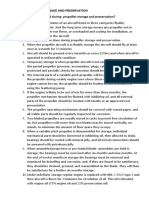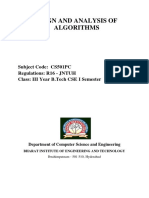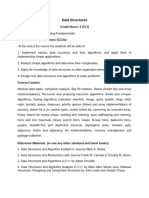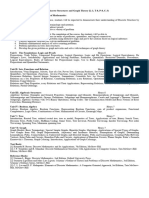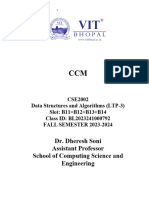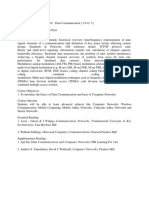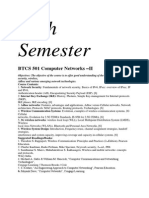BSC Syllabus
BSC Syllabus
Uploaded by
thamizh555Copyright:
Available Formats
BSC Syllabus
BSC Syllabus
Uploaded by
thamizh555Original Description:
Original Title
Copyright
Available Formats
Share this document
Did you find this document useful?
Is this content inappropriate?
Copyright:
Available Formats
BSC Syllabus
BSC Syllabus
Uploaded by
thamizh555Copyright:
Available Formats
L T P C
Basics in Programming (AEC)
3 0 0 2
Course Objective:
1. To Introduce programming language and aware the students about programming paradigm
2. To Focus Fundamentals of Computers and Peripherals
3. To Focus Concept and Methodology of Programming
Course Outcome:
The students will be able to
1. Apply computer programming concepts to new problems or situations.
2. Demonstrate appropriate design, coding, testing, and documenting of computer programs
that implement project specifications and requirements.
3. Develop projects that utilize logical algorithms from specifications and requirements
statements.
4. Understand and use the fundamental concepts of data types, structured programming,
algorithmic design, and user interface design.
5. Categorize different programming languages and their uses.
6. Describe how data are represented, manipulated, and stored in a computer.
Module I
Introduction to Computers & Problem solving: Generation of computers; Computer system:
Basic Block Diagram, super, Main Frame, Mini & Personal computer, Nomenclature; Software:
Systems and Application; Hardware & Software hierarchy; Computing environment,
Algorithms: importance, essential features, design & classifications; Complexity: notation, time
& space
Module II
Number Systems & Arithmetic Number System: Positional, Non-positional, binary, octal,
decimal, hexadecimal and their representation; Methods of conversion from one base to another;
Unsigned, Signed, 1’s Complement, 2’s Complement, sign-magnitude and excess notation; range
of values
Module III
Boolean Algebra: Concepts prepositional logic; Two variable Boolean algebra definitions,
postulates, properties, simplification of logical expressions using properties and maps (up to 4-
variables), Minterm, Maxterm, expressions.
Module IV
C Programming : Introduction: Basic Structure, Character Sets, Keywords, Identifiers Constants,
Variable type declaration; Execution of some simple sample programs. Operators: Arithmetic,
Relational, Logical and Assignment, Increment, Decrement and Conditional; Operator
Precedence and Associations; Expressions in C; Expression evaluation and type conversion
Module V
Operating systems: What is OS; Concepts of Process, Files, Shell, System Calls. Structures:
Monolithic, Layered, Virtual, Client-Server Model. Concept of Synchronization: Semaphores,
Critical Regions, Monitor etc., Inter Process Communication Mechanisms. Processor; Message
Passing, Scheduling; I/O: Devices and Device Controllers; Interrupt handlers and Device drivers.
Module VI
DATA & FILE STRUCTURES: Definitions: Concepts of data types, Elementary Structure,
Words and their interpretation; Arrays: Types, Memory representation, Address translation,
Functions of single and multi dimensional arrays with examples; Linked Structures: Singly
linked list; List Manipulation with Pointers: Examples involving insertion and deletion of
elements
References
1. Manvino & Leach, TMH ;Digital Principal and Application. Seventh edition , Tata
McGraw –Hill Inc Newyork ., 2011.
2. Silberschatz, Abraham, Peter B. Galvin, and Greg Gagne. Operating system concepts.
John Wiley & Sons, 2006.
3. Tanenbaum, Andrew S. Structured computer organization. Pearson Education India,
2016.
4. E. Balagurusamy, TMH ;Programming in ANSI C.Seventh edition, McGraw –Hill Inc
Newyork ., 2017.
University in India: Manipal University
University Abroad: Duke University UK
L T P C
Bioinformatics
3 0 0 3
Course Objectives:
1. To apply basic principles of biology, computer science and mathematics to address complex
biological problems
2. To introduces the students to concepts in bioinformatics
3. To understand the computational challenges (and their solutions) in the analysis of large biological
data sets
Course Outcome:
The students will be able to
1. Describe the history, scope and importance of Bioinformatics and role of internet in
Bioinformatics.
2. Explain about the methods to characterise and manage the different types of Biological
data.
3. Overview the structural organisation, structural properties and various techniques
employed in the structure determination of Biological macromolecules – DNA, Protein
and Carbohydrates
4. Interpret about Multiple Sequence Alignment, its significance, algorithms and tools used
for MSA
5. Simplify about microarray data sequence analysis and expression pattern finding tools
6. Explanation about various approaches in protein three dimensional structure prediction
Module I: Introduction to bioinformatics and data generation (7 Hours)
What is bioinformatics and its relation with molecular biology. Examples of related
tools(FASTA, BLAST, BLAT, RASMOL), databases(GENBANK, Pubmed, PDB ) and
software(RASMOL,Ligand Explorer). Data generation; Generation of large scale molecular
biology data. (Through Genome sequencing, Protein sequencing, Gel electrophoresis, NMR
Spectroscopy, X-Ray Diffraction, and microarray). Applications of Bioinformatics.
.
Module II: Biological Database and its Types (7 Hours)
Introduction to data types and Source. Population and sample, Classification and Presentation of
Data. Quality of data, private and public data sources. General Introduction of Biological
Databases; Nucleic acid databases (NCBI, DDBJ, and EMBL). Protein databases (Primary,
Composite, and Secondary). Specialized Genome databases: (SGD, TIGR, and ACeDB).
Structure databases (CATH, SCOP, and PDBsum)
Module III: Data storage and retrieval and Interoperability (8 Hours)
Flat files, relational, object oriented databases and controlled vocabularies. File Format
(Genbank, DDBJ, FASTA, PDB, SwissProt). Introduction to Metadata and search; Indices,
Boolean, Fuzzy, Neighboring search. The challenges of data exchange and integration.
Ontologies, interchange languages and standardization efforts. General Introduction to XML,
UMLS, CORBA, PYTHON and OMG/LIFESCIENCE.
.
Module IV: Sequence Alignments and Visualization (8 Hours)
Introduction to Sequences, alignments and Dynamic Programming; Local alignment and Global
alignment (algorithm and example), Pairwise alignment (BLAST and FASTA Algorithm) and
multiple sequence alignment (Clustal W algorithm). Methods for presenting large quantities of
biological data: sequence viewers (Artemis, SeqVISTA), 3D structure viewers (Rasmol, SPDBv,
Chime, Cn3D, PyMol), Anatomical visualization.
Module V: Gene Expression and and Representation of patterns and relationship (7 Hours)
General introduction to Gene expression in prokaryotes and eukaryotes, transcription factors
binding sites. SNP, EST, STS. Introduction to Regular Expression, Hierarchies, and Graphical
models (including Marcov chain and Bayes notes). Genetic variability and connections to
clinical data.
Module VI: Protein Tertiary structure prediction methods (8 Hours)
Homology Modeling, Fold Recognition, Abintio Method. Protein folding, Molecular Dynamics
of Protein, Molecular Docking of Protein, Small molecule and Nucleotide, Concepts of Force
Field
References
1. Letovsky, Stanley I., ed. Bioinformatics: databases and systems. Springer Science &
Business Media, 2006.
2. Sorin Draghici. Bioinformatics Databases: Design, Implementation, and Usage
(Mathematical & Computational Biology). CRC Press; 1st edition, 2013
3. Arthur M.Lesk. Data base annotation in molecular biology, principles and practices,
Wiley; 1st edition,2004
4. Tao, Jiang, Ying Xu, Michael Q.Zang; Current topics in computational molecular
biology, A Bradford Book. Cambridge 2002
University in India: Amrita University
University Abroad: University of Chicago
Lab Subjects
L T P C
Bioinformatics Lab
0 0 4 2
Course Objectives:
1. To comprehend the utility of tools & databases available in genomic & proteomics
2. To Store and Retrieve Bimolecular related information using online tools
3. To : Understand the principles and applications Computational technologies on new drug discovery
process.
Course Outcome:
The students will be able to
1. Distinguish knowledge and awareness of the basic principles and concepts of
biology, computer science and mathematics.
2. Demonstrate existing software effectively to extract information from large databases
and to use this information in computer modeling
3. Extend problem-solving skills, including the ability to develop new algorithms and
analysis methods
4. Explain the intersection of life and information sciences, the core of shared concepts,
language and skills the ability to speak the language of structure-function
relationships, information theory, gene expression, and database queries
5. Applying the concepts involved in Computational technology on biomolecular analysis.
6. Executing the recent technology involved in bioinformatics.
Exercises
1. RETRIEVAL SYSTEM AND FILE FORMATS IN PRIMARY SEQUENCE
DATABASES
2. GENBANK
3. EMBL
4. PRELIMINARY ANALYSIS ON VIRAL AND BACTERIAL GENOMES
5. PRELIMINARY ANALYSIS OF C-MYC ONCO PROTEINS FROM SWISS-
PROT/TrEMBL
6. ANALYSIS OF PROTEIN SEQUENCES WITH PROTEIN INFORMATION
RESOURCE DATABASE.
7. ANALYSING THE STRUCTURAL FEATURES OF PROTEIN USING PROTEIN
DATABANK
8. ANALYSING THE GEOMETRY OF PROTEIN AND VISUAVALIZE THE PROTEIN
USING PROTEIN DATABANK AND SWISS-PDB VIEWER.
9. PROTEIN FAMILIES – SCOP, Pfam and CATH
10. BLAST - SIMILAR DNA SEQUENCES SEARCH
References
1. Baxevanis, Andreas D., and BF Francis Ouellette. "A Practical Guide to the Analysis of
Genes and Proteins." Second Edition ,Wily Interscience 2019 .
2. Bujnicki, Janusz M.” Practical Bioinformatics” Second edition, Springer .2004.
3. Shui Qing Ye, Bioinformatics .A practical Approach, Fourth edition , Chapman and
Hall/CRC.2019
University in India: Pondicherry University
University Abroad: University of Yale
You might also like
- 4.236M Parts CatalogDocument53 pages4.236M Parts CatalogShannon McWatters100% (2)
- Answer Key: Introduction To Clinical CodingDocument101 pagesAnswer Key: Introduction To Clinical Codingthamizh555100% (1)
- Windows IoT Enteprise GuideDocument89 pagesWindows IoT Enteprise GuideWong JiaKeen0% (1)
- Loginan YahooDocument18 pagesLoginan YahooNajib EntahapaNo ratings yet
- Ch7 - Storage and PreservationDocument3 pagesCh7 - Storage and PreservationPavan Sushant100% (1)
- BirDogUSB+Manual M3Document24 pagesBirDogUSB+Manual M3Greg MarlerNo ratings yet
- Project Management Software User ManualDocument19 pagesProject Management Software User ManualAmol JadhavNo ratings yet
- TAU Bollards T-STOP PDFDocument2 pagesTAU Bollards T-STOP PDFNoLo ParamartoNo ratings yet
- Sem I - Syllabus - MbiDocument5 pagesSem I - Syllabus - Mbi12 yashika palNo ratings yet
- Computer UG New Syllabus.Document46 pagesComputer UG New Syllabus.Ujjawal TyagiNo ratings yet
- IT UG - New SyllabusDocument48 pagesIT UG - New SyllabusParush AryaNo ratings yet
- SyallbusDocument18 pagesSyallbus0808ci201057.iesNo ratings yet
- Computer Networks (CSGE301) Generic Elective - (GE) Credit:6Document16 pagesComputer Networks (CSGE301) Generic Elective - (GE) Credit:6cristi_pet4742No ratings yet
- Soft Computing Methodologies in TicsDocument7 pagesSoft Computing Methodologies in TicsAB Åttìtúðê ÞêrfëçtNo ratings yet
- Biometrics syllabusDocument10 pagesBiometrics syllabusramyasushilNo ratings yet
- Biometrics Course Policy 2023-24Document12 pagesBiometrics Course Policy 2023-24xx69dd69xxNo ratings yet
- Week Wise Syllabus 1st SemesterDocument7 pagesWeek Wise Syllabus 1st SemesterRehman Ahmad ChNo ratings yet
- MS in CSEDocument17 pagesMS in CSE220010044No ratings yet
- Computational System Biology - NewDocument2 pagesComputational System Biology - Newchirag pandeyNo ratings yet
- Gujarat Technological University: Page 1 of 2Document2 pagesGujarat Technological University: Page 1 of 2parthNo ratings yet
- 1538 Course Details Csc201Document8 pages1538 Course Details Csc201eseosaoshodiNo ratings yet
- Lecture1 BIMM143 LargeDocument73 pagesLecture1 BIMM143 Largepaseczkowo7No ratings yet
- IRS AND PPL SyllabusDocument2 pagesIRS AND PPL Syllabuskarthiksigam143No ratings yet
- Bioinformatics ProgrammersDocument1 pageBioinformatics ProgrammersSrinivasNo ratings yet
- DS - Data Structure Lesson Plan 2022-23Document29 pagesDS - Data Structure Lesson Plan 2022-23kiruba karanNo ratings yet
- Bioinformatics: Sub Code: 07G801 CIE Marks: 100 Hrs/week: 4+0+0 Exam: 3 Hrs Credits: 4 SEE Marks: 100 ObjectiveDocument3 pagesBioinformatics: Sub Code: 07G801 CIE Marks: 100 Hrs/week: 4+0+0 Exam: 3 Hrs Credits: 4 SEE Marks: 100 ObjectiveAmith PatrickNo ratings yet
- ABG-619 course contentsDocument1 pageABG-619 course contentsRabia HanifNo ratings yet
- BIOINFORMATICSDocument4 pagesBIOINFORMATICSCecilia Mukototsi100% (1)
- Bio InfoDocument14 pagesBio InfoNandini JoshiNo ratings yet
- DS Lab Manual CSE_updatedDocument61 pagesDS Lab Manual CSE_updatednagashreeavadhani2011No ratings yet
- Syllabus BigData ENDocument6 pagesSyllabus BigData ENahasanova627No ratings yet
- Question Bank RDocument19 pagesQuestion Bank Rcherry07 cherryNo ratings yet
- Revised Handout 15ec3054 MLCDocument18 pagesRevised Handout 15ec3054 MLCHarish ParuchuriNo ratings yet
- CCI 4101 - Computer Systems and Information Literacy - Course SummaryDocument3 pagesCCI 4101 - Computer Systems and Information Literacy - Course SummaryDENIS OKUMUNo ratings yet
- Global Electives For 7 Semester - 2012 SchemeDocument31 pagesGlobal Electives For 7 Semester - 2012 SchemeYugendra RNo ratings yet
- Course Title Course NumberDocument15 pagesCourse Title Course NumberAbdul WahabNo ratings yet
- CCI 4101 - Computer Systems and Information Literacy - Course SummaryDocument2 pagesCCI 4101 - Computer Systems and Information Literacy - Course Summaryindianjacob72No ratings yet
- Data Science New ReportDocument39 pagesData Science New Reportpriyachinni1205No ratings yet
- Modified Rkr21-Ii Year Ii-SemDocument26 pagesModified Rkr21-Ii Year Ii-SemudemynspNo ratings yet
- Design and Analysis of Algorithms (CS501PC) PDFDocument19 pagesDesign and Analysis of Algorithms (CS501PC) PDFAbdulrasheed O AdetoroNo ratings yet
- 4 Bca 4th Sem Syllabus UemjDocument12 pages4 Bca 4th Sem Syllabus Uemjapi-351162654No ratings yet
- Dsa (18CS32)Document160 pagesDsa (18CS32)sumalraj100% (1)
- BSCS-243 & 239 2nd & 3rd Semester - Fall 2024Document8 pagesBSCS-243 & 239 2nd & 3rd Semester - Fall 2024hurairaqweNo ratings yet
- HandOut of BSCE1003 Application Oriented Programming Using Python - Sanjay SharmaDocument11 pagesHandOut of BSCE1003 Application Oriented Programming Using Python - Sanjay SharmaJagan NathanNo ratings yet
- Syllabus For Third Semester Operating SystemDocument10 pagesSyllabus For Third Semester Operating SystemMicNo ratings yet
- 01-What Is BioinformaticsDocument40 pages01-What Is BioinformaticsmrguochengzongNo ratings yet
- And Applications, Third Edition, BPB Publications, New DelhiDocument6 pagesAnd Applications, Third Edition, BPB Publications, New Delhij_sheriNo ratings yet
- BSIT Course OutlinesDocument16 pagesBSIT Course Outlinestalalzafar05No ratings yet
- Genetic Engineering 3rd Year SyllabusDocument3 pagesGenetic Engineering 3rd Year SyllabusSanthosh RagulNo ratings yet
- C 4 Pnuuiost 85 K 8 Q 6 U 4 Szqiwcerccakq 9Document11 pagesC 4 Pnuuiost 85 K 8 Q 6 U 4 Szqiwcerccakq 9mahdi.alsaadi7No ratings yet
- MSC ItDocument5 pagesMSC Itah2532108No ratings yet
- Syllabus CSE Second Year 13.08.2020 12 25Document14 pagesSyllabus CSE Second Year 13.08.2020 12 25akshaydeshmukh22224No ratings yet
- CSE2002 Data - Structures - and - Algorithm - BL2023241000790 - CCM - DR Dheresh SoniDocument57 pagesCSE2002 Data - Structures - and - Algorithm - BL2023241000790 - CCM - DR Dheresh SoniDheresh SoniNo ratings yet
- SylabiiDocument6 pagesSylabiiashit kumarNo ratings yet
- 3 Bca 3rd Sem Syllabus UemjDocument13 pages3 Bca 3rd Sem Syllabus Uemjapi-351162654No ratings yet
- DBMS Theory-B.Tech CSEDocument2 pagesDBMS Theory-B.Tech CSE20btcse23No ratings yet
- Fifth Semester: BTCS 501 Computer Networks - IIDocument6 pagesFifth Semester: BTCS 501 Computer Networks - IIPrincess deepikaNo ratings yet
- ACSD08Document2 pagesACSD08tsahithi726No ratings yet
- pps 15Document5 pagespps 15mznsdcetNo ratings yet
- UNIT 1 AUTHOR NAVNISH GOEL PPS NotesDocument31 pagesUNIT 1 AUTHOR NAVNISH GOEL PPS NotesmznsdcetNo ratings yet
- Scheme of Studies ADP (IT) and BS (IT) 5th, Bridging Program (2022-24)Document28 pagesScheme of Studies ADP (IT) and BS (IT) 5th, Bridging Program (2022-24)Shahzad ShafiNo ratings yet
- VRsec BIOINFORMATICSDocument2 pagesVRsec BIOINFORMATICSKudipudi SrinivasNo ratings yet
- Bioinformatics Updated Features Applications - Abdurakhmonov I.Y. (Edr.) - 2016Document239 pagesBioinformatics Updated Features Applications - Abdurakhmonov I.Y. (Edr.) - 2016Ankur Das TalukdarNo ratings yet
- 1st Sem PDFDocument19 pages1st Sem PDFAnonymous 16Gz2mqcNo ratings yet
- Course Outlines-SemesterDocument7 pagesCourse Outlines-SemesterZara TariqNo ratings yet
- Sen 411Document9 pagesSen 411rukkyNo ratings yet
- Bioinformatics: Algorithms, Coding, Data Science And BiostatisticsFrom EverandBioinformatics: Algorithms, Coding, Data Science And BiostatisticsNo ratings yet
- Protocols Socra PetrosDocument47 pagesProtocols Socra Petrosthamizh555No ratings yet
- Notification No 310Document10 pagesNotification No 310thamizh555No ratings yet
- Programme - M.Sc. Biotechnology: L T P/S SW/F W Total Credit Units 3 0 0 0 3Document4 pagesProgramme - M.Sc. Biotechnology: L T P/S SW/F W Total Credit Units 3 0 0 0 3thamizh555No ratings yet
- Conformational Plasticity of Ligand-Bound and TernDocument15 pagesConformational Plasticity of Ligand-Bound and Ternthamizh555No ratings yet
- Full Creative - JR Software Engineer Role - Campus Recruitment 2021Document1 pageFull Creative - JR Software Engineer Role - Campus Recruitment 2021thamizh555No ratings yet
- Lecture 23 SlidesDocument44 pagesLecture 23 Slidesthamizh555No ratings yet
- DST-SERB-SRG JRF Notification and ApplicationDocument3 pagesDST-SERB-SRG JRF Notification and Applicationthamizh555No ratings yet
- Lecture 1Document69 pagesLecture 1thamizh555No ratings yet
- Postdoc Position AvailableDocument1 pagePostdoc Position Availablethamizh555No ratings yet
- Using Simulations To Teach Statistical Inference: Beth Chance, Allan Rossman (Cal Poly)Document66 pagesUsing Simulations To Teach Statistical Inference: Beth Chance, Allan Rossman (Cal Poly)thamizh555No ratings yet
- This May Consist of 2 Major Parts: How To Use Autodock Vina?Document7 pagesThis May Consist of 2 Major Parts: How To Use Autodock Vina?thamizh555No ratings yet
- Eukaryotic Gene PredictionDocument61 pagesEukaryotic Gene Predictionthamizh555No ratings yet
- NSCL Recruitment 1Document9 pagesNSCL Recruitment 1thamizh555No ratings yet
- Online FDP - PG MechDocument1 pageOnline FDP - PG Mechthamizh555No ratings yet
- RNA Structure Prediction Software and AnalysisDocument16 pagesRNA Structure Prediction Software and Analysisthamizh555No ratings yet
- D Dobbs ISU - BCB 444/544X: RNA Structure Prediction 1Document41 pagesD Dobbs ISU - BCB 444/544X: RNA Structure Prediction 1thamizh555No ratings yet
- Awasthi2014 PDFDocument17 pagesAwasthi2014 PDFthamizh555No ratings yet
- Promoter PredictionDocument10 pagesPromoter Predictionthamizh555No ratings yet
- Promoter PredictionDocument10 pagesPromoter Predictionthamizh555No ratings yet
- Gene Prediction-2Document138 pagesGene Prediction-2thamizh555No ratings yet
- Annalisa Marsico Wintersemester 2014/15Document56 pagesAnnalisa Marsico Wintersemester 2014/15thamizh555No ratings yet
- Lab #4 SpectrophotometryDocument10 pagesLab #4 Spectrophotometrythamizh555No ratings yet
- Colloids and Surfaces B: BiointerfacesDocument10 pagesColloids and Surfaces B: Biointerfacesthamizh555No ratings yet
- Ranvir (35614901721) STRDocument15 pagesRanvir (35614901721) STRRANVIR CHAUDHARYNo ratings yet
- Midbs Unit 4 Full UnitDocument31 pagesMidbs Unit 4 Full UnitChintoo KalyanadurgamNo ratings yet
- Jueying Lite2 BrochureDocument2 pagesJueying Lite2 BrochuresmoralesNo ratings yet
- Functions of SCADA: 1. Data AcquisitionDocument3 pagesFunctions of SCADA: 1. Data AcquisitionAnil yadavNo ratings yet
- Process Selection and Facility Layout: Operations Management, Eighth Edition, by William J. StevensonDocument43 pagesProcess Selection and Facility Layout: Operations Management, Eighth Edition, by William J. StevensonninyapuellaNo ratings yet
- Energies 12 00649Document22 pagesEnergies 12 00649Executive Engineer HT-2No ratings yet
- Distributed SQL: The Architecture Behind Mariadb Xpand: April 2021Document19 pagesDistributed SQL: The Architecture Behind Mariadb Xpand: April 2021IvyNo ratings yet
- Portfolio Activity Unit 8Document6 pagesPortfolio Activity Unit 8ololadeNo ratings yet
- Antena At12-302ref Panel Fm-RymsaDocument1 pageAntena At12-302ref Panel Fm-RymsaSamuel Joseph Acosta SantosNo ratings yet
- What The Units Are AboutDocument318 pagesWhat The Units Are Aboutapi-285495893No ratings yet
- Askey Dual Cell SFE3060 B1B7Document2 pagesAskey Dual Cell SFE3060 B1B7Rajesh ThimmapuramNo ratings yet
- OCI Quick ODN _Cite performerDocument4 pagesOCI Quick ODN _Cite performerscherubinNo ratings yet
- InfoPLC Net 5 HMI Seminar Hannover Mess 2012Document29 pagesInfoPLC Net 5 HMI Seminar Hannover Mess 2012Robert WagnerNo ratings yet
- SG31G2V2 Silver Shuttle XPC BareboneDocument5 pagesSG31G2V2 Silver Shuttle XPC BarebonedjbobyNo ratings yet
- SCS Series: Industrial FiltrationDocument4 pagesSCS Series: Industrial FiltrationJamin SmtpngNo ratings yet
- Geonics CatalogueDocument12 pagesGeonics CatalogueErnesto BencosmeNo ratings yet
- Do More With MobileIronDocument1 pageDo More With MobileIronkolindronNo ratings yet
- XVR7104 08E 4KL X - Datasheet - 20181121 PDFDocument3 pagesXVR7104 08E 4KL X - Datasheet - 20181121 PDFabdellah belaliaNo ratings yet
- EWIS & FAA RequirementsDocument4 pagesEWIS & FAA RequirementsK SiriusNo ratings yet
- SchneiderDocument6 pagesSchneiderGoran MladenovicNo ratings yet
- Introduction To Malware AnalysisDocument22 pagesIntroduction To Malware AnalysisKrav Maga Worldwide Zaragoza100% (1)
- Driver List Boot ModeDocument13 pagesDriver List Boot ModeNürburgring AutotechnikNo ratings yet
- UM_EN_240816143041Document44 pagesUM_EN_240816143041ray000reyNo ratings yet




